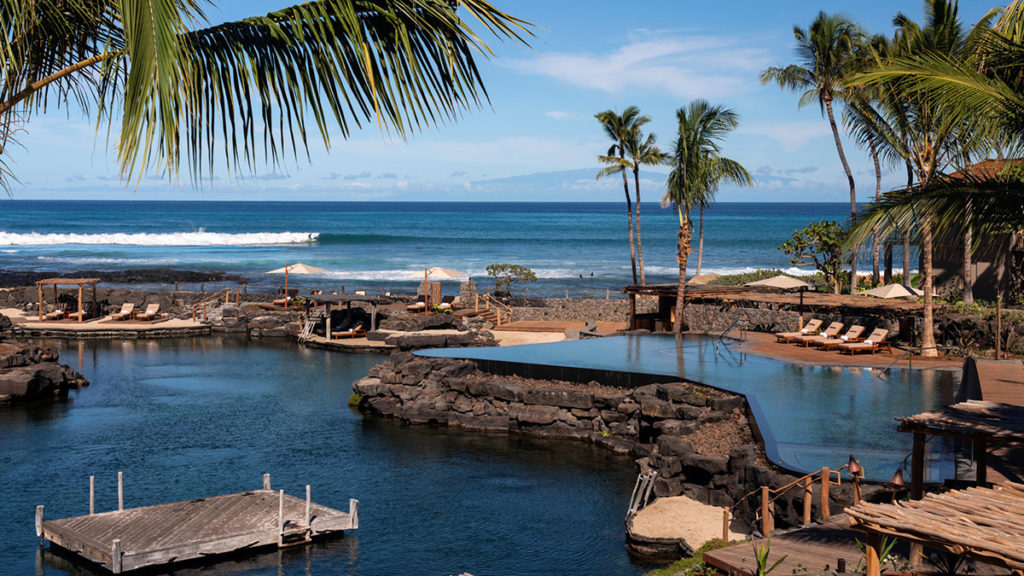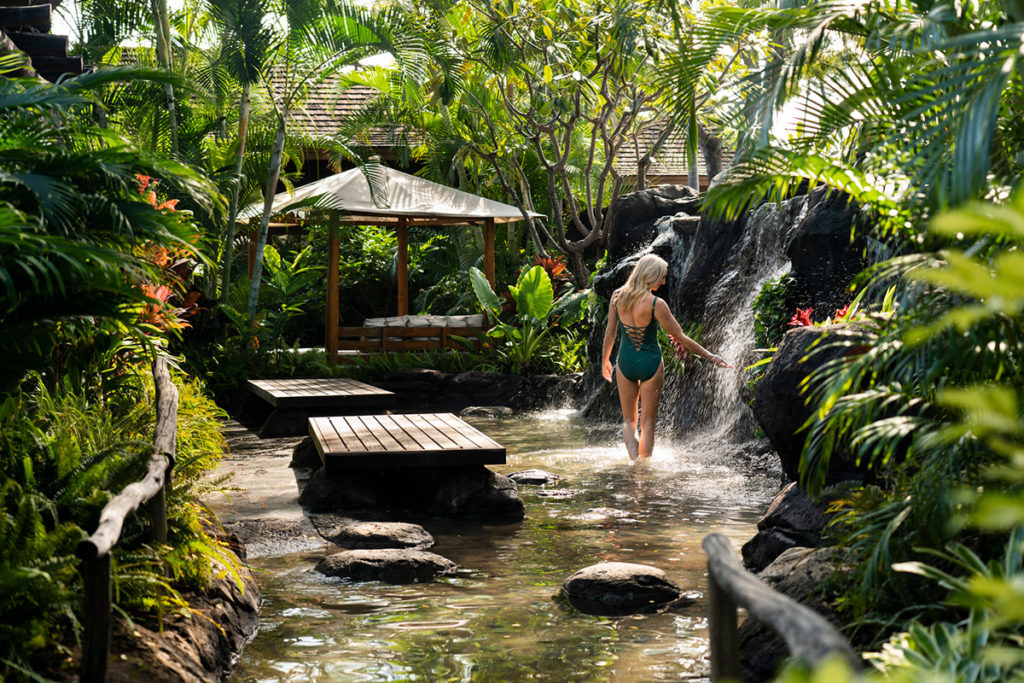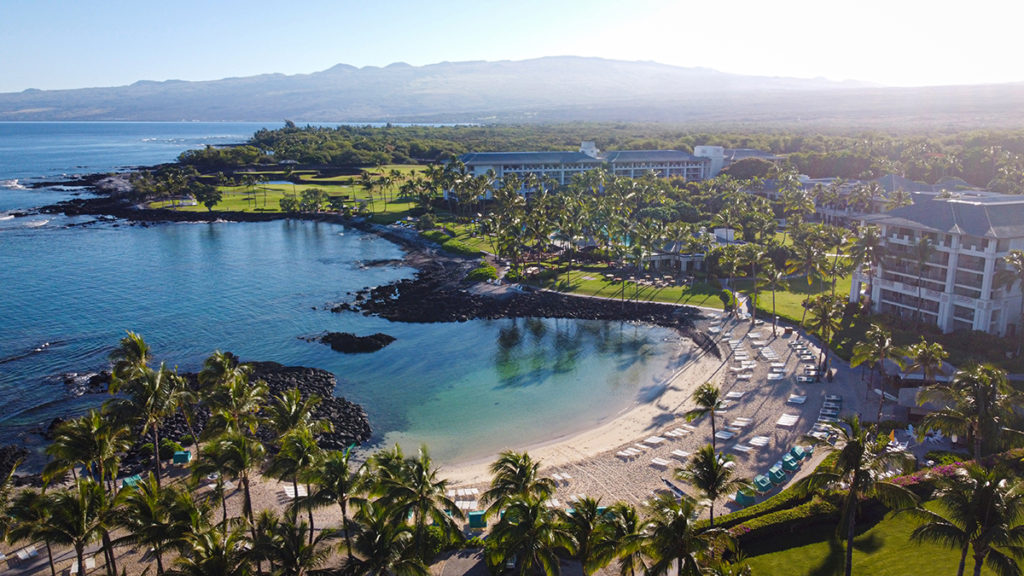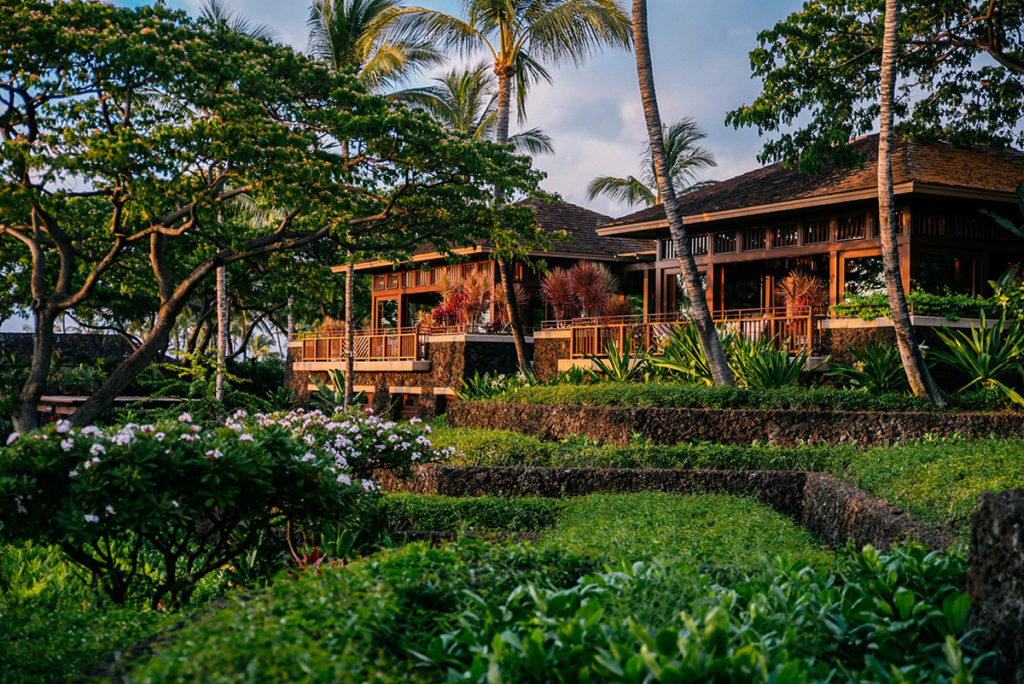
I’ve heard many tourists who have visited the Island of Hawaii, say it has the least impressive beaches out of the main Hawaiian Islands. As a former resident, this is not only laughable, but I would go as far as to say that the Island of Hawaii has some of the best beaches in the island chain. Like Maui, the Island of Hawaii’s volcanic activity has created a variety of interesting and colorful coastlines, from pristine white sand to black and even a green sand beach. Its green sheen comes from the olivine rock-forming mineral, commonly known as peridot in gem form.
A collection of white sand beaches lines the Kohala Coast on the Northwestern shore, approximately one hour north of Kailua-Kona. This famed region not only attracts modern-day elite crowds but was the home of choice to many of Hawaii’s alii, or royals, including King Kamehameha I (the Great) who is revered for uniting the Hawaiian Islands under his rule. His birthplace can be visited in North Kohala near the ruins of Mookini Heiau, a sacred site.
Thanks to this rich history, coupled with the Island of Hawaii boasting the largest population of Polynesian descendants (12 percent of its residents according to a recent state census), the culture seems to be more preserved and perpetuated on the Island of Hawaii than the rest – and this authenticity is showcased in some of the Island of Hawaii’s most esteemed resorts.
Resort Relaxation
 Situated in the alluring Mauna Lani area, the four-star Fairmont Orchid is flanked by its own private beach and lagoon perfect for snorkeling, relaxing in cabanas and marine activities like stand-up paddling and kayaking. Its tranquil guest rooms and suites all have private lanais with views of the ocean, gardens or Hualalai Volcano toward “mauka,” or up toward the mountains. Upgrade to the Fairmont Gold level for a personal concierge, VIP access to the exclusive lounge serving deluxe breakfast, afternoon tea and evening craft cocktails.
Situated in the alluring Mauna Lani area, the four-star Fairmont Orchid is flanked by its own private beach and lagoon perfect for snorkeling, relaxing in cabanas and marine activities like stand-up paddling and kayaking. Its tranquil guest rooms and suites all have private lanais with views of the ocean, gardens or Hualalai Volcano toward “mauka,” or up toward the mountains. Upgrade to the Fairmont Gold level for a personal concierge, VIP access to the exclusive lounge serving deluxe breakfast, afternoon tea and evening craft cocktails.
While the amenities are magnificent, the cultural activities are second to none with the Fairmont’s aim to share the Aloha Spirit by connecting guests to the “aina” (land) through culinary adventures in the new Ulu Pono Garden Experience. The resort’s director of Hawaiian culture Kaiulani Blankenfield guides guests through the Chef’s Garden that features native plants and trees and invites them to harvest fruits, vegetables and herbs while learning about the importance of specific plants to the Hawaiian culture and the culinary landscape, plus a keepsake collection of Hawaiian chili pepper seeds.
If you’re looking to hit the links, Fairmont has a partnership with the Mauna Lani Resort and a 45-hole award-winning championship golf course designed to capture the unique characteristics of Big Island from lava fields to its lush valleys. When you book the “Golf Fore Free in Hawaii” resort package, you’ll have a complimentary tee time for two, a $50 spa credit and a five-night minimum.
 “Fairmont Orchid has a rich history of sharing aloha with visitors from all over the world and we feel it’s our kuleana (responsibility) to invite our guests to care for the land as it cares for us,” said General Manager Charles Head. “This practice of malama (caring for) Hawaii is not only integral in the Hawaiian culture—it’s reflected in our culinary offerings. We take great care to source a majority of our seafood and produce from local purveyors, so our guests may indulge in authentic Hawaii regional cuisine while dining at our signature oceanfront restaurant, Brown’s Beach House.”
“Fairmont Orchid has a rich history of sharing aloha with visitors from all over the world and we feel it’s our kuleana (responsibility) to invite our guests to care for the land as it cares for us,” said General Manager Charles Head. “This practice of malama (caring for) Hawaii is not only integral in the Hawaiian culture—it’s reflected in our culinary offerings. We take great care to source a majority of our seafood and produce from local purveyors, so our guests may indulge in authentic Hawaii regional cuisine while dining at our signature oceanfront restaurant, Brown’s Beach House.”
As its name suggests, Brown’s is a beachfront venue with unique menu items such as Kona Prawns, Big Island Kau Coffee Venison or the Filet Mignon with tempura Maui onion, cheddar ulu mash broccolini and wasabi crème fraiche. Book a private beach dinner at sunset to commemorate a special occasion (or just because the view is incredible!).
 All images by Trevor Clark of CLARKBOURNE Creative.
All images by Trevor Clark of CLARKBOURNE Creative.
A thirty-minute drive south toward Kailua-Kona, will take you across ancient and fresh lava fields to Four Seasons Resort Hualalai, named for the dormant volcano perched about the western side of the Island over Kona. This fall, the five-star resort completed a highly anticipated $100 million property-wide transformation, taking its already luxurious offerings and accommodations to the next level. The renovation was culminated with the unveiling of its top three villas: the Hawaii Loa Presidential Villa, Makaloa Villa and the Hoonanea Villa, which Four Seasons claims are the largest and most luxurious villa accommodations in Hawaii.
In addition to the secluded villas, the revitalization included a new infinity pool and lounge deck at the King’s Pond, Hualalai’s 1.8-million-gallon swimmable aquarium ideal for snorkeling without the worry of the open ocean’s threats, as well as an enhancement of all guest rooms and suites, a transformation of the Signature Hualalai golf course and the addition of the Golf Hale, a 3,000-sq. ft. instruction, practice and entertainment facility. The course is the first designed by Jack Nicklaus on the island, and the facelift introduced an enhanced look with the reshaping of the greens and bunkers, among a modern new Platinum Paspalum turf, enhancing the year-round playing conditions.
“With the conclusion of our renovation, we are proud to begin this iconic Resort’s next chapter by defining a new level of luxury in Hawaii,” says General Manager Charlie Parker. “The most dramatic update was to our villas, responding to our guests’ increased demand for this caliber of accommodations in Hawaii. These distinctly designed villas truly serve as a home-away-from-home for our guests and their extended families and friends.”
Dining at one of the resort’s top restaurants, Ulu and Beach Tree, could arguably be the most opulent experience at Hualalai. Executive Chef Richard Polhemus sources 75 percent of the resort’s ingredients from a collection of 160 farms throughout the Island of Hawaii along with the resort’s herb garden and ponds to comprise his surf and turf creations.
“My entire career has been grounded in a farm-to-table approach. I’ve always let nature and seasonality guide the creation of my menus,” said Polhemus, who joined the Hualalai team recently in 2020. Using local ingredients, curating relationships with purveyors, and embracing the skill of butchery and the nose-to-tail approach has been key to my culinary philosophy.”
Exploring Kohala
 After visiting the aforementioned cultural sites, a visit to Kohala isn’t complete without a day trip up north to the town of Hawi and Pololu Valley. When you reach the end of the road, a breathtaking view awaits with lush greenery, tropical flora and a magical black sand beach at Pololu Valley Lookout. If you’re game for climbing back up the 500 feet of elevation on a moderately difficult trail, then hiking down the switchbacks to the beach is highly encouraged. According to the visitors bureau, there are guides available to provide hiking information and history about the valley.
After visiting the aforementioned cultural sites, a visit to Kohala isn’t complete without a day trip up north to the town of Hawi and Pololu Valley. When you reach the end of the road, a breathtaking view awaits with lush greenery, tropical flora and a magical black sand beach at Pololu Valley Lookout. If you’re game for climbing back up the 500 feet of elevation on a moderately difficult trail, then hiking down the switchbacks to the beach is highly encouraged. According to the visitors bureau, there are guides available to provide hiking information and history about the valley.
En route back to the resorts, stop for lunch and peruse the shops in the quaint town of Hawi, nestled on the edge of the rainforest and best known for being the previous epicenter of Island of Hawaii’s sugar mill industry and the current turnaround site for the annual IRONMAN World Championship 112-mile bike route. In the town center, you’ll encounter eclectic boutiques, charming restaurants and art galleries with authentic souvenirs difficult to find anywhere else in the Islands.
Kohala is just one region to explore, but the Island of Hawaii is massive – six times the size of Oahu to the north. If time allows, I highly recommend exploring the entire island by helicopter. Blue Hawaiian Helicopters is located in the Waikoloa area of Kohala and can easily be accessed from any of the resorts. Guests can experience the current Kilauea Volcano lava flow from the air, the green valleys and waterfalls often only accessible by foot.
To get more involved and immerse yourself in true Hawaiian culture during your visit, the state just launched “Malama Hawaii,” a voluntourism program that facilitates myriad opportunities for visitors to “take a trip that gives back” through sustainable efforts such as beach clean-ups, planting native trees or helping to restore a Hawaiian fishpond. We’ve all heard the cliché phrase, “Take only memories; leave only footsteps,” when we travel, but this initiative allows Hawaii’s visitors to leave a lasting, positive footprint on the Islands.
By Katie Soltas